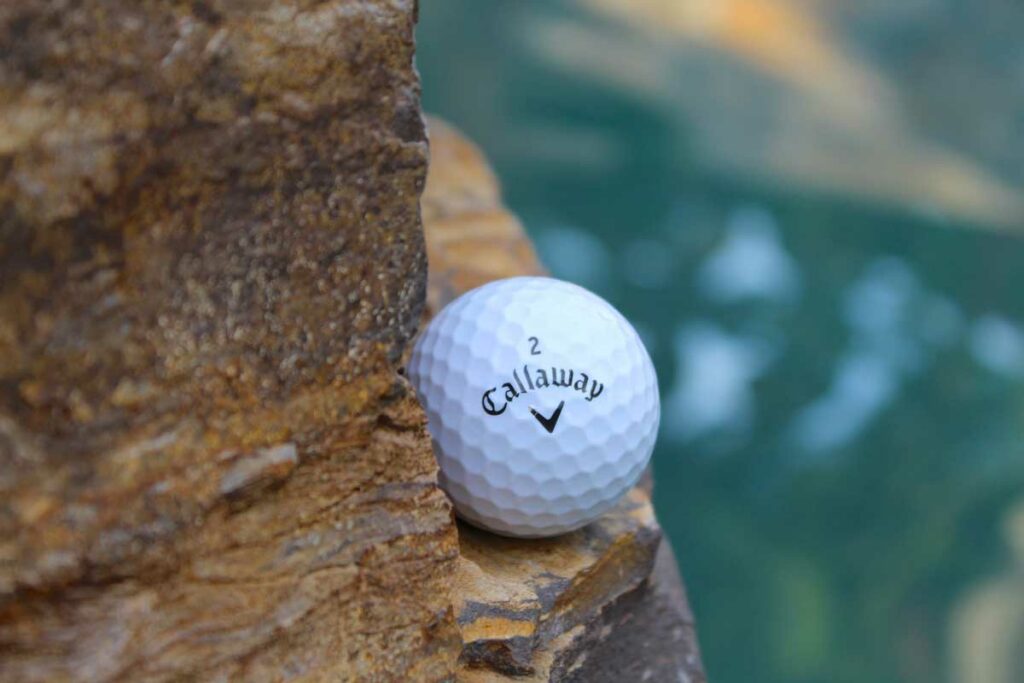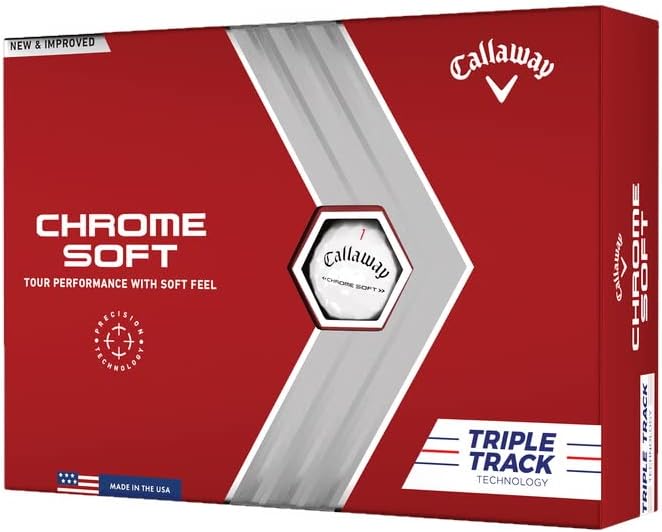
In this Callaway Chrome Soft review we will discuss all the characteristics of the golf ball that revolutionized what we think about tour-quality golf balls.
It is the epitome of zigging while everyone else is zagging.
Most companies have modeled their golf ball lineup after Titleist’s two-ball system with the Pro V1 and Pro V1x.
‘Make a ball that roughly fits the middle of golf’s bell curve, then build a second ball that flies a little higher and spins a little more.’
But not Callaway.
They decided to make something so different from the Pro V1 that the two are almost incomparable.
So much so that Titleist made a different golf ball that could be interpreted as an attempt to compete with the Chrome Soft.
A Chrome Soft golf ball is exactly what the name insists.
The softest tour ball on the market.
With most tour balls measuring around 85 compression or above, this version of the Chrome Soft comes in closer to 70.
Incredibly soft by any standard.
Let’s get to the Chrome Soft review.

What About the Callaway Chrome Soft Sets it Apart
Like the rest of us, Callaway is well aware of Titleist’s and the Pro V1’s dominance over the golf ball market.
Their response?
Dominate a different part of the golf ball market.
That part is the soft ball category.
No matter what people say, a soft golf ball does not have to be played by slow swing speed players.
The same benefits seen by slow swing players can also be seen with high swing speeds.
On the other hand, you might have heard that soft balls are slow balls.
And it is true to some extent.
Soft golf balls don’t offer as much ball speed as firmer golf balls, but they also don’t spin as much.
This lower spin can mitigate some of the distance loss created by decreased ball speed.
And that’s exactly what Chrome Soft excels at.
Not only that, but its low spin performance actually helps alleviate some of the left and right misses that can be common with higher spinning balls.
Callaway Chrome Soft Spin
Wedge Spin: Mid
Iron Spin: Low
Driver Spin: Low-Mid
Unfortunately spin is what the Chrome Soft sacrifices for being as soft as it is.
It’s tough to fight physics on this one.
Softer balls simply don’t spin as much.
However, its urethane cover helps a little bit with greenside spin, giving it a little bit of grab on short game shots.
But don’t expect the Chrome Soft to spin anywhere near some of its tour-level counterparts.
The spin simply won’t be there.
Great for drives. Not so great for wedges.
Callaway Chrome Soft Trajectory
Iron Trajectory: High
Driver Trajectory: Low
The lack of spin means the Chrome Soft needs another way of stopping on those all-important approach shots.
The only other option, or at least the best option, is with its ball flight.
The higher it can fly with a steeper descent angle, the quicker it will stop around the green.
Lucky for the Chrome Soft, it does just that.
The deficiency in spin will still be noticeable, especially for longer iron shots, but short irons and full wedges will still perform admirably.
It might not spin back like a tour pro with his ball on a string, but you should not see any sort of excessive rollout.
Does it Have Enough Distance?
Driver Distance: Average
Iron Distance: Long
The part about soft golf balls being slow definitely plays a part here.
Especially off the driver.
When compared to other premium golf balls, the Chrome Soft is one of the slowest balls off the driver.
That speed picks up a little bit off irons, but it’s still not the best.
Fortunately, it isn’t Callaway’s first rodeo at making a soft golf ball so they have become pretty good at mitigating the loss of speed with other characteristics.
For example, lower spin with higher flight means longer distance.
It’s tougher to do this with a driver because tee shots don’t launch as high.
However, this can definitely be seen with mid-irons as Chrome Softs are among the longest balls in this category.
Not THE longest.
But they’re within shouting distance.
Firmness (Or Lack Thereof)
Compression Rating: 70-75 (Soft)
The piece de resistance of the Callaway balls.
The Chrome Soft comes in as their lowest compression premium golf ball.
Much softer than what you’ll get from other premium or tour-level balls, but still has an average compression rating if you compare it to all the golf balls in the marketplace.
It’s definitely this soft on purpose.
Callaway is firmly trying to stake its claim in being the best at making this type of golf ball.
And, frankly, they are doing a pretty good job at it.

Callaway Chrome Soft Review: Final Thoughts
Good For: High-spin golfers who want a softer feel. Or beginners trying to break into the premium golf ball market.
Price: $50 – Shop Now
Construction: 3-Piece (Changed from last model’s 4-Piece)
Cover: Urethane
Dimples: 332
Buy If:
- You want Tour Performance with a softer feel.
Don’t Buy If:
- You need more spin.
- You want more distance off the tee.
In the past decade Callaway has had a microscope on itself from the golf industry for its golf ball impurities.
Hopefully, this Chrome Soft review does a little bit to dispel some of its critics.
They have still not fully recovered from some of the dramatic uncoverings found with off-center cores, but they have made incredible strides in fixing a known issue.
If you are new to the golf ball world, you’d be forgiven for wanting to compare the Callaway Chrome Soft to the Titleist Pro V1.
I promise they are not the same and they should not be compared in the same breath.
The Chrome Soft is an extremely soft option and should be played by a select type of golfer who needs less spin on their shots. (See if the Chrome Soft fits your game.)
It can be a great bridge to playing a premium golf ball if you have solely been playing soft, beginner-type golf balls as it will be the softest of the elite models.
And it will still give you some forgiveness that’s commonplace with those types of golf balls.
If you want to see how the Callaway Chrome Soft compares to other balls in the industry, see our full guide.



Leave a Reply